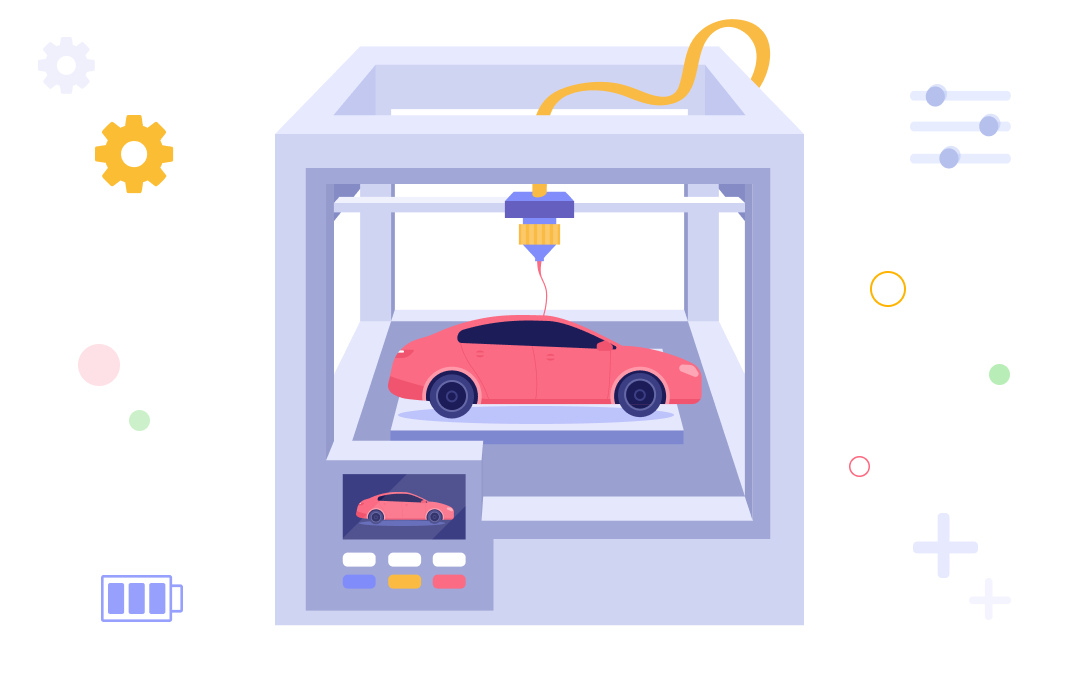The automotive world is experiencing the most substantial change since Henry Ford industrialized manufacturing a century ago. It’s important that the current transformation is triggered not only by extensive technology development but also by social demand. It appears that our future will be all about accessible mobility: mobility solutions will be more flexible, individualized, and compatible. Let’s consider what innovations are driving this new automotive revolution.
An Overview of the Latest Automotive Industry Trends
The present-day automotive industry is affected by innovative ideas and is ready to transform and evolve rapidly. Current ecological, social, and technological trends are encouraging automotive manufacturers to offer consumers much more than a metal box on four wheels. Whereas for the past 100 years, carmakers were largely focused on enhancing manufacturing to become more efficient at scale, the future is about redefining the role of the vehicle – now it’s rather a smartphone or computer on wheels.
New technology in the automotive industry opens up new opportunities. AI, additive manufacturing, the Internet of Things, and 5G have become sources of product innovation and manufacturing efficiency, which in turn has led to revolutionary changes in customer experience.
In recent years, the automotive industry has been affected by the following trends:
- Electrification,
- Self-driving cars,
- Connectivity,
- Sustainability,
- Mobility-as-a-Service,
- Implementation of advanced safety features.
These tendencies are long-term and are expected to continue shaping the auto industry in the near future. In the next sections, we’ll explore these and other automotive sector trends in more detail, and see how they will evolve in 2024.
Future Trends in the Automotive Industry: 2024 Outlook
We expect to see the following automobile trends next year.
1. Electric Cars
The worldwide shift to electric cars is one of the most prominent trends in automobile industry. Environmental factors have driven the growth of zero-emission vehicle technology, and the popularity of cleaner and more environmentally friendly electric vehicles (EVs) and hybrid electric vehicles (HEVs) is still increasing. The battery technology and charging infrastructure required for electric vehicles are also evolving – for example, lithium-ion batteries that have certain limitations can now be replaced by solid-state batteries that have higher energy density, are safer, more stable, and cost-effective. [1]
Major vehicle manufacturers are investing in the production of electric cars. For example, General Motors, Volvo, Aston Martin, and Jaguar Land Rover are planning to manufacture only electric cars in the foreseeable future. Next year, there’s going to be a considerable increase in the adoption of electric vehicles. By the year 2030, 55 percent of all cars sold in Europe are expected to be fully electric. [2]
2. Self-Driving Vehicles
Innovative manufacturers take considerable interest in the potential of self-driving technology since it opens new opportunities for business growth. Up-to-date, autonomous vehicles are in the early stage of development: among the 6 levels of driving automation, there are only Level 3 (conditional automation) and some Level 4 (high driving automation) vehicles available in some regions. [3].
Despite the fact that fully autonomous driving is at least several years away from the present, in 2024 and beyond, this technology is expected to be actively developed and tested, and the number of autonomous cars on roads will increase.
3. Mobility-as-a-Service (MaaS)
Mobility-as-a-Service has been among the latest trends in automotive industry for some years – it has become a popular convenient and cost-effective alternative to traditional car ownership and personal vehicles. The technology involves the integration of diverse transportation means into a single platform for delivering all-embracing mobility services. The platforms may include public transportation, taxis, micromobility vehicles, car leases, or their combinations. The MaaS market is growing and will continue to develop in 2024 and in the years ahead, which is explained by the increased variety of transportation options – ride/car/bike sharing, passenger cabs, commuter trains, and other mobility options. Also, the MaaS market growth is facilitated by increased connectivity, the adoption of 5G and 4G LTE technologies as well as wireless communications using smartphones. [4]
4. Alternative Fuels
This is one of the new trends in automotive industry, which is to some extent in conflict with electrification. However, there are still a great number of fuel-driven cars, and despite the shift to producing electric vehicles, some car manufacturers don’t want to use batteries in their automobiles for some reasons. So, the so-called e-fuels become a greener alternative to traditional fuel, which is also used beyond the automotive industry. E-fuels embrace e-kerosene, e-methane, or e-methanol which are produced as a result of synthesizing CO2 emissions and using renewable CO2-free electricity. Currently, despite their earlier ban, the European Commission has agreed to allow the selling of cars running on e-fuels after 2035, but on condition that they will have no climate impact. So, the production of this fuel may increase in the coming years. [6]
5. Automotive Supply Chain Issues
The automotive industry is one of the most severely affected by supply chain disruptions. Currently, its greatest challenge is instability, which is expected to persist next year. This is explained by several factors.
- Talent shortages: automotive manufacturers suffer from high employee turnover, which continues to decline;
- The shift to electric vehicles and incorporation of advanced features in vehicles: it causes a gap between the increased demand for specific components (semiconductors, batteries) and the available supply;
- Reliance on global supply chains: the COVID-19 pandemic has revealed their vulnerability and a number of auto manufacturers are relocating their production plants.
- Geopolitical tensions: military conflicts in some regions of the world also contribute to intensifying supply chain challenges.
Currently, auto manufacturers as well as auto OEMs (original equipment manufacturers) are trying to address the above-mentioned difficulties by investing in automation and relying less on the global supply chain. However, it takes time and isn’t capable of solving the supply chain problems quickly enough. [7]
Other Technology Trends in Automotive Industry
Technology in automotive industry forges ahead – the latest technological advancements are more and more extensively used by the domain. Let’s see what automotive technology trends are expected to drive the industry’s progress next year.
Connected Vehicles: Trend for Smarter Cars
Connectivity has become a really game-changing innovation in automotive industry that will transform the future of driving. Combined with 5G technology, it turns a car into a talking supercomputer able to create wireless networks to communicate in real time with all traffic infrastructure including vehicles and traffic lights. Cars are becoming unprecedentedly smarter, and this trend is here to stay in the future. Seamless connectivity between automobiles, infrastructure, and pedestrians is expected to become commonplace and help increase traffic safety and improve driver experience. [2]
One of the most in-demand connectivity solutions is in-vehicle infotainment – the systems that provide both information and entertainment for enhanced driving experience. The currently available infotainment systems can connect with smartphones, sensors, ADAS (advanced driver assistance systems) as well as other in-vehicle and external systems. In the foreseeable future, the main infotainment trends will embrace the focus on cybersecurity, AI integration with voice recognition systems for seamless interaction with users as well as producing larger high-resolution displays. In 2024, a great number of car manufacturers are planning to improve their infotainment systems providing them with more and more advanced capabilities (Jeep, Tesla, Nissan, KIA, etc.).
Advanced Safety Features: New Requirements
Safety has been one of the key trends in automotive industry. 2024 is no exception – automotive manufacturers are expected to continue implementing more and more advanced safety features in their vehicles. For instance, the European Union has updated the General Safety Regulation (GSR) that establishes mandatory safety requirements for cars sold in the EU. According to this regulation, starting from 2024, the following features become compulsory.
- Advanced Driver Assistance Systems (ADAS).
They include autonomous emergency braking, lane departure warning, driver monitoring systems, and must be installed in every new passenger car and light commercial vehicle.
- Enhanced crash test standards.
The new standards involve more comprehensive testing procedures and aim to increase the vehicles’ safety performance.
- Protection of pedestrians and cyclists.
This becomes possible thanks to advanced sensors and cameras as well as emergency braking systems.
- Intelligent speed assistance.
It’s the advanced technology that leverages GPS and data mapping to warn drivers of exceeding the speed limit. It can also change the speed of the vehicle if required.
- Data recording.
New cars should have data recorders that will gather information on the vehicles’ performance. In case of an accident, this data will be used in the investigation and for further vehicle safety improvements. [5]
Therefore, safety systems in vehicles are becoming more and more advanced year by year providing more sophisticated driving assistance and minimizing the chances for human error, so this trend is expected to remain in 2024 and beyond.
3D Printing: Revolution in Automotive Manufacturing
The main advantage of this digital technology is that it allows auto manufacturers to create complex and at the same time lightweight vehicle parts. 3D printing them is faster than traditional manufacturing and cheaper, which makes the whole process more efficient. Also, additive manufacturing makes prototyping more rapid, which enables faster design and testing periods for new vehicles. As the technology evolves and becomes more affordable for the industry, it opens more and more opportunities every year.
5G: Advanced Connectivity
Connectivity is one of the key trends in automotive industry, and 5G is what takes it to a more advanced level. 5G facilitates faster data transmission, higher network and bandwidth capacity as well as improves security (e.g., protection from cyberattacks). As a result, vehicles become even more connected with each other and the infrastructure and provide drivers with more advanced opportunities.
Immersive technologies: VR & AR
These technologies are widely used across a great number of industries and the automotive domain is no exception. They are used by the automotive industry for car manufacturing, employee training as well as vehicle sales and marketing.
Of course, this list of technologies isn’t exhaustive, and the industry is also taking advantage of big data and analytics, blockchain technology, and artificial intelligence, each of which has its own role in the development of trends listed in this article.
Final Words
The automotive industry has been experiencing disruptive changes in recent years. The latest technologies have revolutionized the way vehicles are designed, manufactured, and sold, and the vehicles themselves have become much more than a means of transport.
Basically, the trends seen in previous years will remain in 2024 and are likely to become automotive future trends. The most prominent of them will be electrification, connectivity, Mobility-as-a-Service market growth, advanced safety as well as the application of recent technologies – AI, 5G, 3D printing, immersive technologies, and blockchain.
References
- Rajaraman, V. Technology Ruling the Automotive Trends for 2023-2024. Express Computer.
- Bhargav, S. (2023) Top Automotive Industry Trends To Watch In 2024. Technotification.
- The 6 Levels of Vehicle Autonomy Explained. Synopsys.
- Global Mobility as a Service Market Outlook. Expert Market Research.
- Driving Safety in the Age of GSR 2024: How Driver Monitoring Systems Can Help. Jungo.
- Abnett, K. (2023). EU Set to Demand E-fuel Cars Have No Climate Impact. Reuters.
- Youd, F. (2023). Supply Chain Chaos – Issues, Causes, and Potential Solutions. Just Auto.


